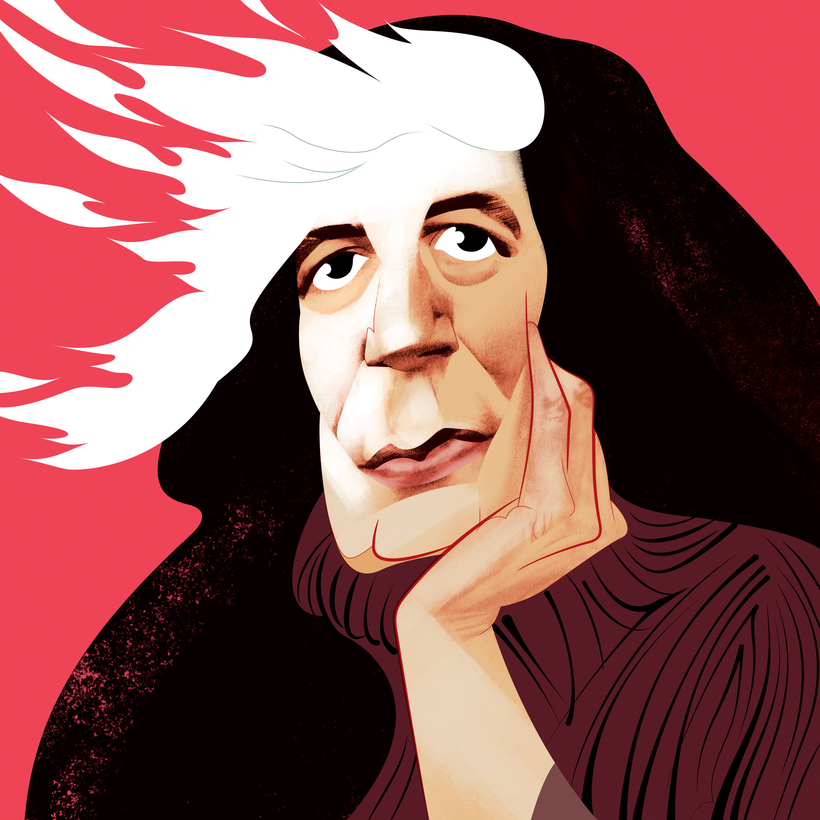The first thing you notice about Benjamin Moser’s massive biography of Susan Sontag is that the cover has no type on it, no author’s or subject’s name. It’s just a photograph—we don’t need to identify who it is. Sontag, more than any writer of the period, perhaps of any period, was iconic: her coal-black hair divided down the middle by a white skunk’s stripe was as instantly recognizable as Marilyn Monroe’s platinum coif, and as meaningful to the culture. It defined the idea of the modern.
Perhaps it’s hard to remember now how transformative, how shattering Sontag’s first collection of essays, Against Interpretation, was when it appeared on the scene in 1966. I read it that summer, sitting on the terrace of my home in suburban Chicago, and discovered at 17 the life of art. To say that the style was original doesn’t begin to explain it; it pulsed with cerebral authority. Her main argument—that art could only be experienced, not understood, that its supreme value was to elicit feeling—bristled with moral seriousness. In Conrad’s famous formulation, it made you see.
Sontag’s coal-black hair, divided by a white skunk’s stripe, was as recognizable as Monroe’s platinum coif, and as meaningful to the culture.
It also introduced a new canon. The Romanian philosopher E. M. Cioran, the German critic Walter Benjamin, the Bulgarian writer Elias Canetti: these would become touchstones for the young intellectual on his Evanston terrace and for a whole generation of aspiring intellectuals. They possessed an aura of Continental glamour that made writing a romantic enterprise, a vocation.
But it wasn’t just the pursuit of literature that drove Sontag (though she is estimated to have owned 20,000 books). It wasn’t just the consuming ambition to be a writer. She demanded a place on the world’s stage. She was a global Zelig. She dominated headlines. She reported from Vietnam, staged Waiting for Godot in war-torn Sarajevo, directed a film on the Yom Kippur War, visited China and Cuba. She exhibited physical courage. She was president of PEN at a turbulent moment in its history. And she fought her toughest battles of all on the internal front: she was diagnosed with breast cancer at 42 and, after a recurrence, died in agony of acute leukemia at 71, her body charred black from the ravages of a bone-marrow transplant. It was a big life, a monumental life, a life that, more than most, mattered.
On a Personal Level
Alas, it was a small life, too. I have almost never read a biography of someone whose personal faults were so egregious. “I loved her,” said the critic Leon Wieseltier, “but I didn’t like her.” Many did love her; she was charismatic, intense, graced with an incandescent mind; she could be loving (though she rarely was); her giant presence filled the room. But—and this is the paradox of Sontag’s character—she was histrionic and often uncomprehending, a grandiose figure whose ego obstructed her judgment and made her seem grotesque in her need to dominate. She held her own criticism in contempt, and thought people who didn’t love her fine novel about Emma Hamilton, The Volcano Lover, were stupid.
She lied and was cruel to her lovers. She prevaricated about admitting she was gay. (Though whose business was it anyway?) She went off to Italy with a girlfriend while her son was in the midst of a nervous breakdown. She was such a mass of contradictions that no biographer could do her justice. After reading Benjamin Moser’s 800-page monument—a monument scarred with the stigmata of the author’s impatience and even intermittent bursts of rage—I felt for the guy. No way to sum up this monster-genius: no way to get it right.
Moser, the author of a biography of the Brazilian novelist Clarice Lispector, has interviewed the people who were closest to Sontag, along with many others who knew her (or thought they did). The principal figure is the celebrated photographer Annie Leibovitz, her lover and primary benefactor: it was Leibovitz who paid for Sontag’s cars and private flights and an apartment on the Seine in Paris. (Moser reports that she gave Sontag an estimated $8 million over the years.)
There’s also Sontag’s son, David Rieff, born of a marriage to Philip Rieff, an instructor at the University of Chicago, when she was 17. It has long been rumored that Sontag wrote Philip’s one important book, Freud: The Mind of the Moralist—not assisted him but really wrote it. Moser—and here is why we need biographers—describes the moment, four decades after its publication, when a copy of the book arrived at Sontag’s door inscribed to the “co-author of this book.”
After reading Benjamin Moser’s 800-page monument, I felt for the guy. No way to sum up this monster-genius.
Before there was “Susan Sontag” there was Sue, an awkward, preternaturally brainy girl who grew up in Tucson and Los Angeles, where she interviewed Thomas Mann when she was 16. Like most great men and women, she came out of nowhere. What makes her story so enthralling is the implausibility of it. Where did this person who requires no name to identify her come from? Why did Susan Sontag exist?
Moser can be a clunky biographer—repetitive, abstract, wordy. Sample sentence: “The tension between persona and person becomes untenable when reality resurges, and avenges itself upon the dream.” Yet, in part because his subject is so utterly compelling, and because he gets her ideas, he has managed to write a biography that is dramatic, even suspenseful: how will this genius, so hungry for experience, so needy, so afraid of being alone that she once told a friend that she would rather live with anyone picked out of a Chinese restaurant than live alone, so courageous, so hated and so loved, so loyal as a friend, so treacherous as a friend, so knowing about everything except who she was, so insensitive and obtuse, manage to survive life? And how did others manage to survive her? The writer Jamaica Kincaid said: “I don’t think I ever wanted to be a great person after I knew Susan.”
James Atlas was not just an acclaimed biographer (Saul Bellow, Delmore Schwartz) but an accomplished publisher, having started the popular Penguin Lives series. He also happened to be an unusually kind and amiable fellow, which meant that hundreds of people (including a few of us here at AIR MAIL) were lucky enough to call him a friend. Jim died of a chronic lung ailment on September 4 in Manhattan at age 70. This is his final piece of writing, with changes dictated from his hospital bed


